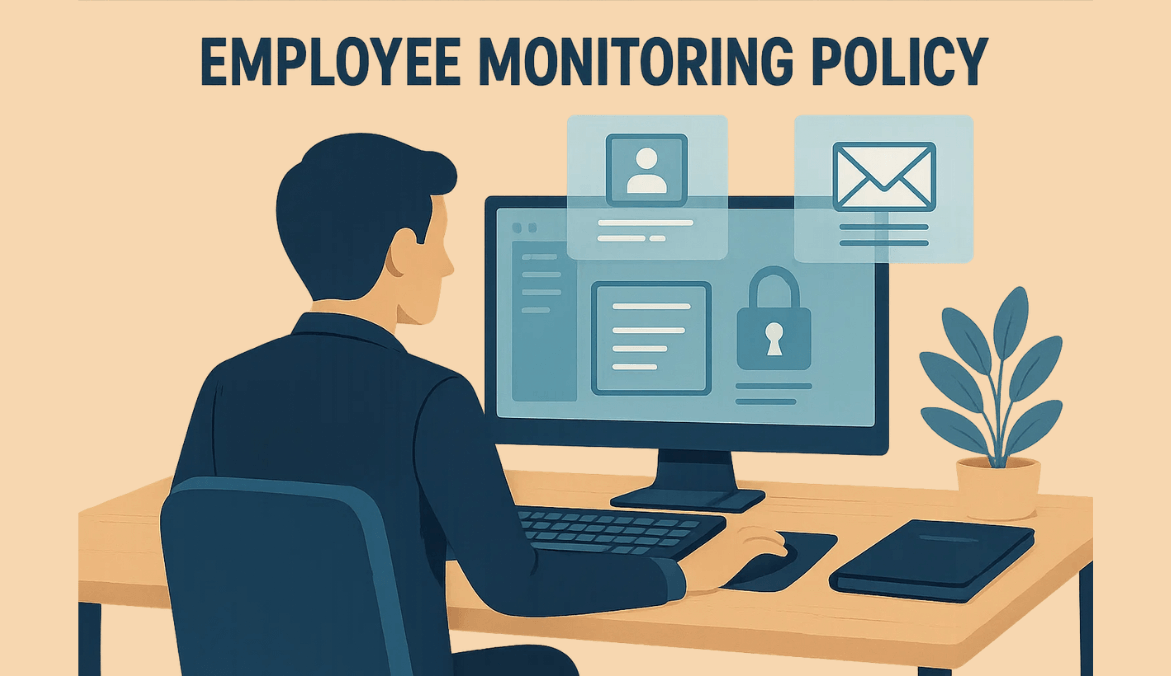Introduction
If you’re here, you’re probably facing the same challenge I’ve seen dozens of companies wrestle with over the years: how do you monitor employees in a way that boosts productivity and security without crossing into “big brother” territory?
The answer lies in a well-crafted Employee Monitoring Policy. It’s not just paperwork, it’s your blueprint for balancing trust, compliance, and business needs. Let’s walk through it together.
What Is an Employee Monitoring Policy?
Recent research shows that 78% of companies report using employee monitoring software to track worker performance and online activity. (ET CIO)
At its core, this policy spells out what you monitor, why you monitor it, and how you protect employee rights in the process.
Think of it like house rules. Employees deserve to know if their emails, app usage, or logins are being tracked, and you deserve a framework that keeps everything legal and transparent.
Actionable advice: If you can’t explain a monitoring method in a sentence your employees would accept, it probably doesn’t belong in your policy.
Legal & Ethical Foundations
Research shows that when companies are upfront about monitoring, employee acceptance increases — Gartner found a 20% boost in acceptance of email monitoring after clear communication. (Current Ware)
Here’s where most organizations get nervous. Yes, monitoring is legal in many countries, but the rules shift dramatically depending on where your people work.
- In the U.S., you often need consent or at least clear notice.
- In the EU and UK, GDPR requires you to prove you’ve got a lawful basis and that your approach is proportionate.
- In India, with the DPDP Act kicking in, transparency and purpose limitation are becoming key.
💡 From my experience: One tech company I advised almost landed in hot water because their policy didn’t specify data retention. They had years of old logs sitting in storage — until legal counsel flagged it as a liability. A single missing clause can create years of headaches.
Actionable advice: Don’t just copy a template. Localize your policy with legal review and build in a retention clause that limits how long you hold on to sensitive monitoring data.
Policy Architecture: The Building Blocks
Here’s what every solid monitoring policy should include:
- Purpose & scope – Why you monitor and who it applies to.
- Definitions – Make terms like “personal data” crystal clear.
- What you monitor – Be specific: apps, logins, emails, or device activity.
- Where and when – On company devices? During work hours only? Spell it out.
- Data handling – Who has access, how long you keep it, and how you delete it.
- Prohibited practices – Private areas, union activity, and anything outside work hours.
- Employee rights – How staff can ask questions, request copies, or raise concerns.
- Enforcement – What happens if rules are broken.
I’ve noticed the biggest blind spot is usually around “prohibited practices.” Without this, employees assume you might monitor everything, including personal calls or private chats. The moment we added a “what we will never monitor” clause for one client, morale improved overnight.
Actionable advice: Don’t just say what you’ll do, also be clear about what you won’t do.
Monitoring Methods Matrix
Not every tool is right for every company. Here’s a quick way to think about it:
- Email & app usage – Low-risk, often justified. Great for spotting phishing or shadow IT, but make sure you’re not reading personal emails.
- Screen captures or keystrokes – High-risk, very intrusive. Use only if absolutely necessary for security investigations, never for routine productivity checks.
- CCTV / access control – Common in offices, but limit to entrances, exits, and shared workspaces. Never in private areas.
- GPS tracking – Okay for delivery staff, field technicians, or drivers. Not appropriate for remote desk workers.
- File access & downloads – Useful for data loss prevention (DLP). Helps identify unusual copying of sensitive files.
- USB & external devices – Monitoring plug-ins can prevent data theft but explain clearly why this is needed.
- Print monitoring – Sometimes overlooked, but still relevant in industries handling confidential data.
- Call logging & recordings – Standard in call centres for quality and compliance but be transparent and set clear retention limits.
- Chat/IM monitoring (Slack, Teams, WhatsApp Business) – Can be appropriate for compliance-heavy sectors but needs clear scope and purpose.
- Network traffic monitoring – Low visibility to employees but essential for IT security. Should be explained in broad terms (“we monitor for malware and security threats”).
- Productivity dashboards (time spent on apps/sites) – Moderate risk. Can help identify bottlenecks, but should be role-specific, not “one-size-fits-all.”
- AI-based behavioural analytics – Emerging tool. Very powerful, but high-risk. Needs strong justification, transparency, and clear limits.
From experience: One of the most common mistakes I see is companies piling on too many monitoring methods at once. The more tools you add, the harder it is to justify each one. A lean, purposeful mix usually builds more trust and is easier to defend legally.
Actionable advice: For every monitoring method, run it through this test: Does it solve a real business or compliance need, and can I explain it in a single sentence employees would accept? If not, cut it.
BYOD, Remote & Hybrid Nuances
With remote and hybrid work, blurred lines are the norm. Here’s what to remember:
- BYOD (Bring Your Own Device): Use containerization or clear opt-in clauses. Don’t touch personal files.
- Remote workers: Monitoring should stick to work hours. Family privacy matters.
- Hybrid setups: Be consistent — the same rules should apply whether someone is in the office or at home.
- Actionable advice: Always separate company-owned and personal devices in your policy. That single distinction will save you from countless disputes.
Change Management & Trust
Rolling out monitoring is less about IT, more about people. If employees feel blindsided, you’ll create distrust that no policy can fix.
💡 Real-life story: At a financial services firm, we introduced monitoring by running a townhall where employees could ask anything anonymously. The result? Fewer rumours, less resistance, and adoption rates nearly doubled compared to “silent” rollouts I’d seen before.
Actionable advice: Launch with transparency. Tell people what’s monitored, why it matters, and — crucially — what isn’t monitored.
A U.S. survey found that 1 in 9 employees quit due to excessive monitoring, while 90% said strict reporting creates dissatisfaction, burnout, and fear. (WorldatWork)
Step-by-Step: How to Create Your Policy
- Define your purpose and scope.
- Map the data you’ll collect.
- Choose monitoring methods carefully.
- Draft clauses using a template.
- Get legal review.
- Communicate and gather consent.
- Train managers to answer questions.
- Review and refine annually.
Actionable advice: Don’t launch until your managers can confidently explain the policy in their own words. If they’re shaky, employees will be too.
Putting Policy into Action with Mera Monitor
An employee monitoring policy is only as strong as its execution. Mera Monitor bridges the gap between written rules and day-to-day practice by ensuring monitoring is consistent, transparent, and fair.
- Seamless Policy Alignment: Activities tracked in Mera Monitor can be directly tied to the guidelines in your monitoring policy, creating a system that enforces compliance without ambiguity.
- Built-in Transparency: With clear dashboards, automated timesheets, and activity reports, employees understand exactly what is being monitored—and what isn’t—reducing concerns about overreach.
- Fairness & Accountability: Standardized attendance, activity, and productivity tracking eliminates selective enforcement, ensuring every employee is evaluated on the same criteria.
- Data-Driven Reviews: Since policies need to adapt over time, Mera Monitor delivers actionable insights that help managers refine and update policies based on real trends and outcomes.
👉 Bring clarity and consistency to your monitoring policy. Start your Free Trial or Book a Demo today to see how Mera Monitor turns policies into trusted practices.
Measuring Success
Trust is measurable too. In one study, 76% of employees said they trust their employer to use monitoring data fairly, and 74% believed their employer was transparent about its use. (Buddy Punch)
Success isn’t just about catching policy violations. It’s about trust and balance.
- % of employees who’ve acknowledged the policy.
- Reduction in security incidents.
- Audit results.
- Employee sentiment (via surveys).
From my experience: The most reliable metric isn’t productivity dashboards — it’s employee trust. I’ve seen teams work harder simply because they felt the policy was fair.
Actionable advice: Measure both compliance and sentiment. Numbers tell you if it works; feedback tells you if it’s sustainable.
Common Pitfalls to Avoid
- Collecting more data than you need.
- Forgetting to review regional laws.
- Monitoring off-hours activity.
- Skipping a retention/deletion process.
Actionable advice: Review your policy annually. Tech and laws evolve faster than most companies realize.
Conclusion
A strong Employee Monitoring Policy isn’t about micromanagement — it’s about clarity, trust, and compliance. With a well-structured policy, your team knows exactly where the boundaries are, and you protect your business from legal and cultural missteps.
Actionable advice: Start small, communicate openly, and review often. The goal isn’t just oversight — it’s building a culture of accountability and trust.
FAQs
Yes, but with important conditions. Most jurisdictions allow some form of monitoring as long as it’s tied to a legitimate business purpose (like protecting company data, ensuring productivity, or meeting compliance requirements). However, the way you monitor must be proportionate — meaning you can’t collect more data than you need. Transparency is key: employees should know what is being monitored and why. In some countries (like parts of the U.S.), simple notice is enough; in others (like the EU/UK), you need to prove lawful basis under GDPR.
💡 Tip from experience: I’ve seen companies get into trouble not because they monitored, but because they didn’t communicate it properly. The act itself may be legal, but secrecy often leads to complaints or legal scrutiny.
Not always — it depends on where you operate.
- In the U.S., many states allow monitoring with prior notice, and consent isn’t always mandatory.
- In the EU/UK, GDPR requires a lawful basis — and while “legitimate interest” may apply, many companies still seek documented consent or at least acknowledgement.
- In India (under the DPDP Act), transparency and consent are becoming central, especially for personal devices or sensitive data.
The safest practice? Get explicit acknowledgment. Even if local law doesn’t require it, having written acceptance builds trust and gives you a layer of legal protection.
There are red lines. Some things are off-limits in almost every jurisdiction:
- Private spaces (restrooms, locker rooms, or any non-work area).
- Personal phone calls, private messages, or family communications.
- Protected activities (like union organizing or legally protected discussions).
Even if the law in your country doesn’t spell it out, ethics and trust demand you stay away from overly invasive practices. Monitoring in these areas damages morale and can expose you to lawsuits.
💡 Pro insight: When drafting policies for clients, I always add a “What we do not monitor” clause. It instantly reassures employees and reduces anxiety.
Only as long as it serves the specific purpose you stated in your policy. Holding data indefinitely is a liability. A common best practice is to set clear retention periods, such as:
- 30–90 days for routine logs.
- 6–12 months for security/audit data.
- Longer (case-by-case) for ongoing investigations or compliance requirements.
After the retention period, data should be securely deleted or anonymized.
 Gift Card ₹999
Gift Card ₹999

